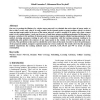Free Online Productivity Tools
i2Speak
i2Symbol
i2OCR
iTex2Img
iWeb2Print
iWeb2Shot
i2Type
iPdf2Split
iPdf2Merge
i2Bopomofo
i2Arabic
i2Style
i2Image
i2PDF
iLatex2Rtf
Sci2ools
AHSWN
2010
2010
Dynamic Point Coverage Problem in Wireless Sensor Networks: A Cellular Learning Automata Approach
One way to prolong the lifetime of a wireless sensor network is to schedule the active times of sensor nodes, so that a node is active only when it is really needed. In the dynamic point coverage problem, which is to detect some moving target points in the area of the sensor network, a node is needed to be active only when a target point is in its sensing region. A node can be aware of such times using a predicting mechanism. In this paper, we propose a solution to the problem of dynamic point coverage using irregular cellular learning automata. In this method, learning automaton residing in each cell in cooperation with the learning automata residing in its neighboring cells predicts the existence of any target point in the vicinity of its corresponding node in the network. This prediction is then used to schedule the active times of that node. In order to show the performance of the proposed method, computer experimentations have been conducted. The results show that the proposed me...
| Added | 08 Dec 2010 |
| Updated | 08 Dec 2010 |
| Type | Journal |
| Year | 2010 |
| Where | AHSWN |
| Authors | Mehdi Esnaashari, Mohammad Reza Meybodi |
Comments (0)

